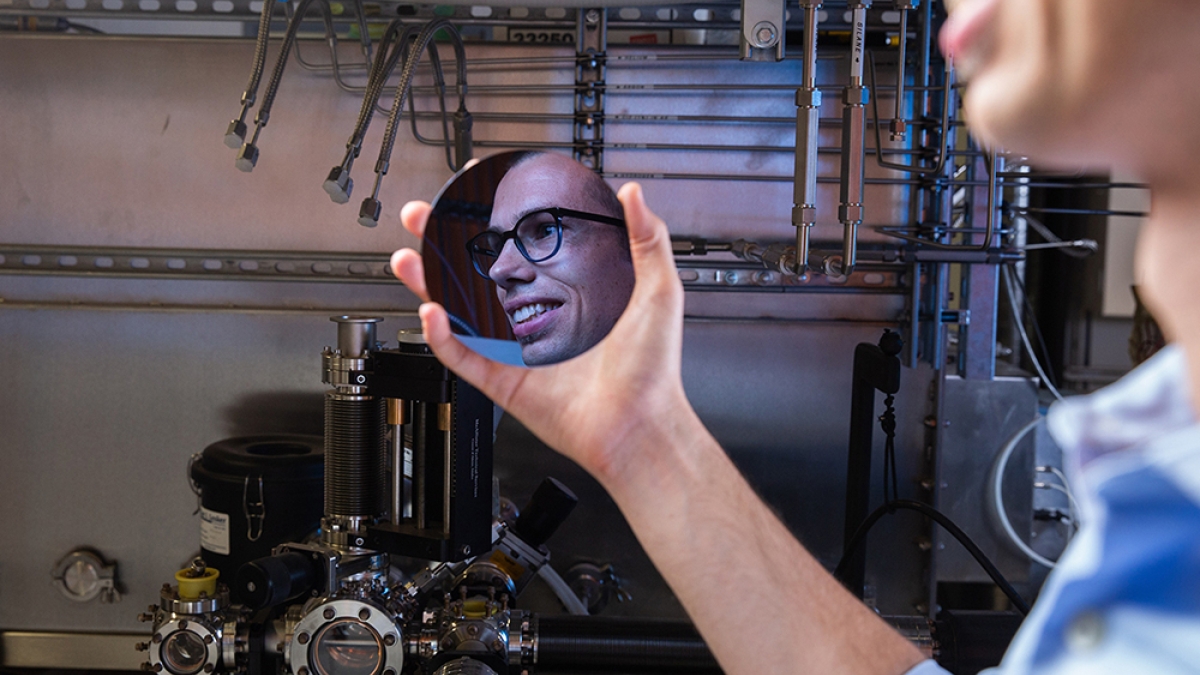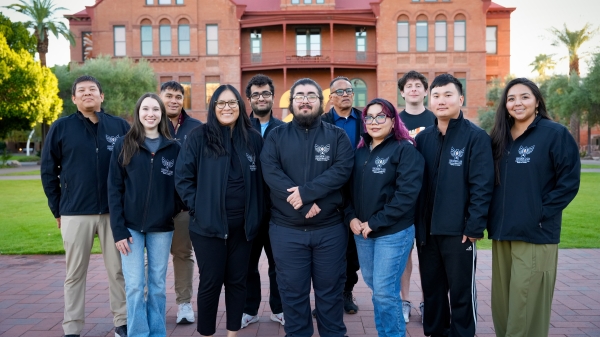Arizona State University radiant with solar cell research awards

ASU Assistant Professor Zachary Holman reflects on the efficiency of new solar technologies vs. the costs. Photo by Deanna Dent/ASU Now
Arizona State University recently earned six prestigious Department of Energy awards, totaling nearly $5.7 million, ranking it first among university recipients of Solar Energy Technologies Office (SETO) awards to advance photovoltaic research and development in 2018.
Overall SETO funding in 2018 totaled $53 million for 54 projects with a focus on affordability, flexibility and performance of solar technologies on the grid. SETO funds early-stage research projects that advance both solar photovoltaics and concentrating solar-thermal power technologies, and it supports efforts that prepare the solar workforce for the industry’s future needs.
In 2017, ASU researchers won six of 19 SETO awards, garnering $4.3 million — more than 25 percent of total funding in the category that year. Since 2011, ASU has received more than $41.7 million in photovoltaic research funding from the Department of Energy.
“For the third year in a row, ASU faculty members have won more SETO awards than any other academic institution,” said Sethuraman “Panch” Panchanathan, executive vice president of knowledge enterprise development and chief research and innovation officer at ASU. “As leaders in the field of photovoltaics, we are changing the game for tomorrow’s energy solutions.”
The SETO awards program was established in 2011 with a goal of making solar cost-competitive with conventional energy sources by 2020; the program is now at 90 percent of its goal of $0.06 per kilowatt-hour and recently expanded its target to $0.03 per kilowatt-hour by 2030.
ASU’s most recent SETO awardees
Andre Augusto, an associate research scientist in the Fulton Schools of Engineering’s School of Electrical, Computer and Energy Engineering, received a $200,000 award to investigate the potential advantages of using undoped silicon wafers, which are a pure crystalline form of silicon, to make high-performance solar cells. These studies will help better understand the effects of doping levels (chemical additives to the silicon) on light and polarization-induced degradation. This research aims to lower the cost of energy by improving photovoltaic cell and ingot manufacturing yield, silicon cell power output and module reliability.
Mariana Bertoni, an assistant professor in the School of Electrical, Computer and Energy Engineering, received $250,000 to continue her “spalling research,” a disruptive technology that cuts silicon wafers without kerf losses — the amount of material lost in the cutting process — and results in high-quality silicon wafers at twice the yield and half the cost of traditional wafering methods.
Increasing affordability, reliability and manufacturability of photovoltaic cells, modules and systems are the focus of two awards of $1.5 and $1 million to Zachary Holman, an assistant professor in the School of Electrical, Computer and Energy Engineering.
Holman and his team will develop a characterization platform for non-silicon-based devices in order to gather a precise accounting of power losses that limit device performance. While tools and techniques for silicon-based devices are available, there aren’t comparable ones for non-silicon devices. Materials other than silicon used in solar cells include novel amorphous silicon contacts and cadmium telluride absorbers. These will be characterized using multiple bulk and interface loss-analysis methods. The team will examine a wider range of absorber materials and create a platform that enables users to rapidly and accurately assess the quality of a wide range of bulk materials and surface passivation layers, including contact selectivity and contact resistivity.
A second award will focus on manufacturable, high-performance silicon solar cells developed through an innovative deposition technique that will improve cell efficiency and reduce equipment and material costs. In order to arrive at the ideal contact stack that’s transparent and can easily be made with inexpensive tools and precursors, the silicon community has been experimenting with stacking new materials within solar cells. The team will develop a gas-flow sputter source coupled to an aerosol-driven assembly tool and they will use the tool to deposit any type of metal oxide carrier-selective layer or transparent conductive oxide layer with full control of the material composition, without damaging the underlying layers.
Holman’s team, which includes Assistant Research Professor Zhengshan “Jason” Yu, broke its own world record in late 2018 by attaining 25.4 percent tandem solar cell efficiency.
Govindasamy Tamizhmani, an associate research professor at Fulton Engineering’s Polytechnic School, has a $1.5 million award for reliability evaluation of bifacial and monofacial glass modules. Photovoltaic modules with glass/glass encapsulation are expected to be more resistant to breakage and degradation than glass/backsheet modules. However, many glass/glass-module architectures continue to use ethylene vinyl acetate as an internal encapsulant that has been linked to significant device-life limiting reliability issues, including glass cracking, encapsulant delamination and encapsulant browning. This project will assess the merits and shortcomings of glass/glass modules with EVA and non-EVA encapsulants by evaluating new and field-aged modules. The team will then evaluate the expected reliability of these modules in indoor and outdoor accelerated tests.
Innovative approaches and models to enable Puerto Rico’s low- and moderate-income communities to better understand how they can use solar energy to improve resilience and energy affordability are the focus of Clark Miller’s $1.3 million award. Miller, a professor in the School for the Future of Innovation in Society, and his team will analyze and model different approaches for expanding solar energy access, including household, business, community and utility-based solar solutions. Researchers will map the solar opportunity for low- and moderate-income communities in Puerto Rico and conduct deeper analysis of specific representative communities.
Quantum Energy and Sustainable Solar Technologies
In addition to access to abundant sunshine, another reason for ASU’s prominence in photovoltaic research is its QESST, an engineering research center co-funded by the National Science Foundation and Department of Energy that launched in 2011. QESST has established ASU’s engineering program as a powerhouse in photovoltaics and plays a key role in leveraging SETO-funded research.
QESST, the largest university photvoltaics research center in the United States, is the only university facility in the U.S. where full-sized silicon solar cells can be made – drawing researchers from around the world in the mission to advance photvoltaic technologies.
“Photovoltaics requires the integration of so many disciplines – chemistry, materials science, additive manufacturing and so on,” explained Christiana Honsberg, a professor in ECEE and QESST director. “The collaborative nature of ASU not only enables our faculty to work together, it also supports collaboration with other universities and private industry. ASU is working on joint photovoltaics research initiatives around the world,” she said, noting projects in Ireland, Australia and Mexico.
“Our deep experience and high-level approach to photovoltaics definitely play a role in our funding success, despite the highly competitive nature of the field,” she said.
More Science and technology

Indigenous geneticists build unprecedented research community at ASU
When Krystal Tsosie (Diné) was an undergraduate at Arizona State University, there were no Indigenous faculty she could look to…

Pioneering professor of cultural evolution pens essays for leading academic journals
When Robert Boyd wrote his 1985 book “Culture and the Evolutionary Process,” cultural evolution was not considered a true…

Lucy's lasting legacy: Donald Johanson reflects on the discovery of a lifetime
Fifty years ago, in the dusty hills of Hadar, Ethiopia, a young paleoanthropologist, Donald Johanson, discovered what would…